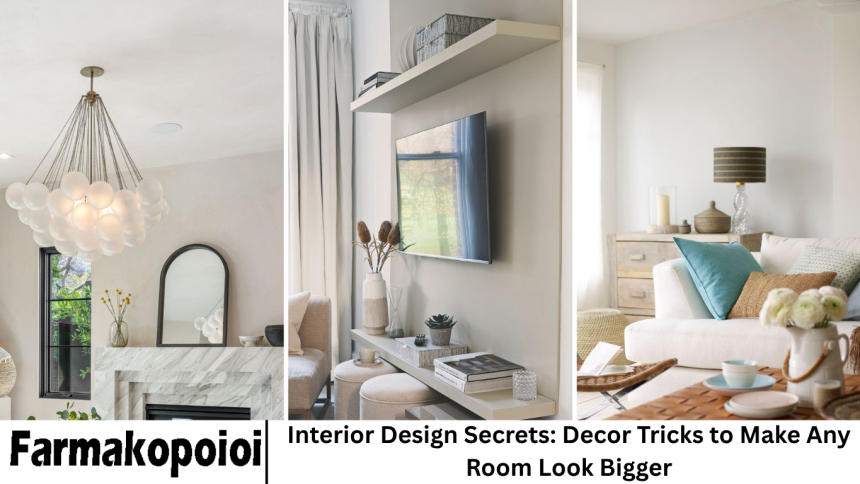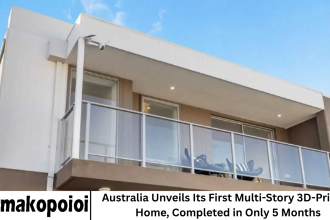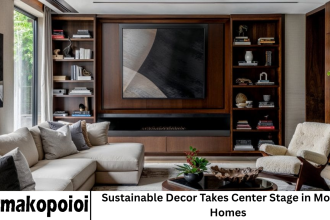In the world of interior design, size doesn’t always determine style or comfort. Many of us live in homes or apartments where every inch counts — cozy city studios, compact bedrooms, or narrow living rooms. Yet with the right design approach, even the smallest of spaces can feel open, airy, and inviting.
- Start with a Minimalist Mindset
- Color Magic: Using Light Shades to Open Up a Room
- Strategic Lighting: Let There Be Light
- Mirror Illusions: Reflecting Space and Light
- Smart Furniture Choices and Placement
- Flooring and Rugs: Foundation for Visual Flow
- Vertical Emphasis: Drawing the Eye Upward
- Texture and Materials: The Art of Lightness
- Declutter with Style: Organized Space Feels Bigger
- Artwork and Accessories: Scale and Placement Are Key
- Use Glass and Open Design Elements
- Indoor Plants: Breathing Life into Small Spaces
- Zone Definition Without Walls
- Reflective and Metallic Accents
- The Psychology of Space: How Our Minds Perceive Rooms
- Frequently Asked Question
- Conclusion
Creating the illusion of space isn’t about tearing down walls or spending a fortune. It’s about using clever design strategies — color, lighting, furniture placement, and visual balance — to manipulate how our eyes perceive a room. From the use of mirrors to the art of decluttering, small tweaks can make a huge impact.
This guide explores the most effective interior design secrets and decor tricks to make any room appear larger and more harmonious. Whether you’re decorating a small apartment, a tiny guest room, or just want your home to feel more expansive, these insights will help you design a space that breathes.
More Read: Sustainable Decor Takes Center Stage in Modern Homes
Start with a Minimalist Mindset
Less Is More — The Power of Simplicity
One of the simplest yet most transformative ways to make a room look bigger is to embrace minimalism. When you strip away unnecessary clutter, you give your space room to breathe — visually and physically. Every object in the room should serve a purpose, whether functional or aesthetic.
A cluttered space not only looks smaller but also feels chaotic. Try to follow the “one in, one out” rule — whenever you bring a new piece of decor in, remove something else. Use sleek storage solutions like ottomans with hidden compartments or wall-mounted shelves to keep surfaces clear.
Minimalism doesn’t mean your space has to feel bare. Instead, focus on quality over quantity — a few statement pieces can make a bigger impression than a collection of small, mismatched items.
Color Magic: Using Light Shades to Open Up a Room
Light Colors Reflect, Dark Colors Absorb
Color plays one of the most powerful roles in creating the illusion of space. Light colors reflect more light, which visually expands a room, while darker hues absorb light and make spaces feel more enclosed.
Neutral tones like soft whites, light grays, creams, and pale blues are ideal for small rooms. They create an airy, open atmosphere and allow natural light to bounce around.
To add depth and contrast, use accents of darker shades on furniture, decor, or even one feature wall. A pale gray room with charcoal cushions or a beige room with navy accents can feel sophisticated without feeling cramped.
If you prefer color, consider cool undertones like light mint, sky blue, or lavender. These hues visually recede, making walls appear further away.
Strategic Lighting: Let There Be Light
The Right Lighting Can Double the Perceived Space
Lighting isn’t just functional — it’s psychological. A well-lit room instantly feels larger, while dark corners make spaces feel confined. The key is to layer lighting to eliminate shadows and create even illumination.
Start with natural light. Keep window treatments minimal — opt for sheer curtains or light-filtering blinds that allow sunlight to flow freely. Avoid heavy drapes that block daylight.
For artificial lighting, use a combination of ambient, task, and accent lighting. Ceiling fixtures, wall sconces, and strategically placed lamps can work together to create depth and dimension.
Pro tip: Use upward-facing lamps or wall washers to direct light toward the ceiling — this visually raises the height of the room. You can also install recessed lighting or LED strips under cabinets and furniture to create floating effects.
Mirror Illusions: Reflecting Space and Light
A Designer’s Secret Weapon
Mirrors are one of the oldest tricks in the interior design playbook — and for good reason. A well-placed mirror can double the sense of space by reflecting both light and scenery.
Position a large mirror across from a window to amplify natural light and give the illusion of another window. Alternatively, use multiple smaller mirrors arranged in a grid or gallery wall for a modern, artistic effect.
Mirrored furniture — such as side tables or cabinets with reflective surfaces — can also subtly enhance spaciousness without overwhelming the design. If you’re working with narrow spaces, long vertical mirrors can make ceilings appear higher, while horizontal mirrors can widen a room visually.
Smart Furniture Choices and Placement
Scale, Proportion, and Layout Matter
When it comes to furniture in small rooms, scale is everything. Large, bulky pieces dominate a space and make it feel cramped. Instead, choose low-profile furniture with sleek lines and exposed legs. The more floor you can see beneath furniture, the larger your room appears.
Opt for multi-functional furniture like a sofa bed, nesting tables, or a dining table with expandable leaves. Floating desks and wall-mounted storage units also free up valuable floor space.
Layout also plays a crucial role. Avoid pushing all furniture against the walls — instead, leave a few inches of breathing space. This small gap creates the illusion that walls extend further than they actually do.
Additionally, maintain open sightlines. Arrange furniture to keep pathways clear and avoid blocking windows or doors. An unobstructed view across a room makes it feel open and welcoming.
Flooring and Rugs: Foundation for Visual Flow
Uninterrupted Lines Create Spacious Continuity
Flooring can influence how large or small a room feels. Continuous flooring throughout your home — such as hardwood, laminate, or large-format tiles — creates visual continuity, making rooms flow seamlessly into one another.
Avoid abrupt changes in flooring types between rooms; they visually break up the space and make areas feel smaller. When using rugs, choose light-colored, low-contrast designs. Large rugs that extend under furniture help unify a room, while multiple small rugs can chop up the space.
For extra visual height, lay flooring planks or tiles diagonally or lengthwise to draw the eye across the room. This simple tweak tricks the brain into perceiving more space.
Vertical Emphasis: Drawing the Eye Upward
Maximize Height, Minimize Clutter
Small rooms don’t always lack width — often, they just need vertical balance. Designing upward draws attention to the ceiling, making the room feel taller and more open.
Install floor-to-ceiling curtains to create vertical lines that elongate walls. Even if your windows are small, mount curtain rods closer to the ceiling for maximum effect. You can also use tall bookshelves, vertical artwork, or paneling to emphasize height.
Paint the ceiling a shade lighter than your walls, or add subtle vertical stripes to your decor — both techniques make walls seem higher. Avoid hanging artwork too low, as this can make ceilings appear lower than they are.
Texture and Materials: The Art of Lightness
Mix, Match, and Maintain Balance
While colors affect how big a room feels, textures and materials influence how open it feels. Smooth, light-reflecting materials like glass, metal, and polished wood make spaces appear brighter and more expansive.
For example:
- Glass coffee tables create visual transparency.
- Acrylic chairs (like the iconic Louis Ghost Chair) maintain an airy aesthetic.
- Glossy finishes on cabinets or flooring bounce light around the room.
Combine these with soft textures — light linen curtains, neutral rugs, and woven baskets — to add warmth and comfort without heaviness. Avoid overly busy patterns or heavy fabrics, as they can overwhelm smaller spaces.
Declutter with Style: Organized Space Feels Bigger
Storage Solutions That Double as Decor
Clutter is the enemy of spacious design. Even a well-decorated small room can look chaotic if it’s overloaded with items. The key is discreet storage — spaces that hide clutter while blending seamlessly with your decor.
Use built-in shelving, under-bed storage, or furniture with drawers to keep things out of sight. Floating shelves can display a few curated pieces — books, plants, or art — without overwhelming the walls.
Keep surfaces like tables and countertops clear, and use baskets or boxes in matching colors to create visual uniformity. A tidy space automatically feels more serene and expansive.
Artwork and Accessories: Scale and Placement Are Key
Curate, Don’t Crowd
When decorating walls in a small space, scale and arrangement make all the difference. Large art pieces can actually make a room look bigger — as long as they’re properly balanced.
Instead of cluttering walls with small frames, choose one or two statement artworks. Hang them at eye level and leave plenty of surrounding space so they “breathe.”
If you love gallery walls, keep frames and colors consistent for a cohesive look. Mirrors, minimalist art, or photography with open landscapes can visually extend a room. Accessories should also be used sparingly. A few thoughtfully chosen decor items make a bigger impact than many small trinkets.
Use Glass and Open Design Elements
See-Through Design Expands Visual Boundaries
Transparency can create visual openness. Use glass partitions, acrylic chairs, or open shelving instead of solid barriers. In bathrooms, opt for frameless glass shower enclosures instead of shower curtains to visually extend the floor area.
In living spaces, glass doors or see-through railings maintain flow between zones. The more you can see through your decor and furniture, the less confined your room feels.
Indoor Plants: Breathing Life into Small Spaces
Nature’s Trick for Freshness and Scale
Plants are excellent at softening a room and making it feel alive — but in small spaces, balance is key. Choose a few medium-sized plants over many small ones. Tall, slender plants like snake plants or fiddle-leaf figs draw the eye upward, creating height and freshness.
Use hanging planters or wall-mounted pots** to save floor space. Greenery against light walls adds natural contrast and depth without cluttering the area.
Zone Definition Without Walls
Smart Layout for Open-Plan Living
If you’re dealing with an open layout, defining zones without adding barriers can help make your home feel organized yet spacious. Use area rugs, lighting variations, or different textures to subtly separate the dining, living, and work areas.
Furniture arrangement also helps — a sofa back can serve as a room divider without closing off the space. The goal is to create distinction while maintaining visual flow.
Reflective and Metallic Accents
Shimmer That Expands the Room
Metallic accents like brass, chrome, or gold can catch and reflect light beautifully. Use metallics in small doses — like lamp bases, frames, or mirror edges — to enhance brightness without overwhelming your decor.
Reflective surfaces bounce light around and add sophistication. Combine metallics with matte finishes for visual contrast and balance.
The Psychology of Space: How Our Minds Perceive Rooms
Design That Feels as Big as It Looks
Our brains are easily tricked by design illusions. Light, symmetry, and clean lines signal openness and calm. Dark colors, clutter, and asymmetry signal confinement.
Designing with optical balance in mind helps spaces feel more expansive. Even if your room isn’t physically large, the right layout, light, and materials can convince the eye otherwise.
When you design with intention — considering flow, proportion, and harmony — every corner contributes to the perception of space.
Frequently Asked Question
What color makes a small room look the biggest?
Light, cool tones like white, soft gray, and pale blue reflect light and visually expand the space. Avoid dark or overly warm colors, which can make rooms feel enclosed.
Do mirrors really make a room look bigger?
Yes. Mirrors reflect both light and surrounding elements, creating the illusion of depth and doubling the perceived space, especially when placed opposite windows.
How can I make a small living room feel more open?
Use multi-functional furniture, keep pathways clear, add layered lighting, and stick to a cohesive color palette. Transparent or low-profile furniture can also help.
What type of flooring makes a room look larger?
Light-colored, wide-plank flooring or continuous materials (like hardwood throughout the home) visually stretch the space. Diagonal layouts also create a longer perspective.
Should small rooms have minimal furniture?
Yes — but not too minimal. Choose fewer, functional pieces that fit proportionally. Furniture with visible legs and sleek lines maintains an airy, open feel.
How can I make low ceilings appear higher?
Use floor-to-ceiling curtains, vertical artwork, and upward lighting. Painting the ceiling a lighter shade than the walls also enhances height perception.
Can patterns work in small rooms?
Yes, but use them sparingly. Subtle, large-scale patterns or vertical stripes can add depth and height, while busy, small patterns can overwhelm the space.
Conclusion
Transforming a small space into a spacious sanctuary is both an art and a science. By playing with light, scale, and color, you can alter perception and create rooms that feel inviting, not confined.
Remember — it’s not about the square footage; it’s about smart design decisions. From minimalist decor and strategic lighting to airy furniture and reflective accents, these interior design secrets prove that small can indeed be spectacular.






















